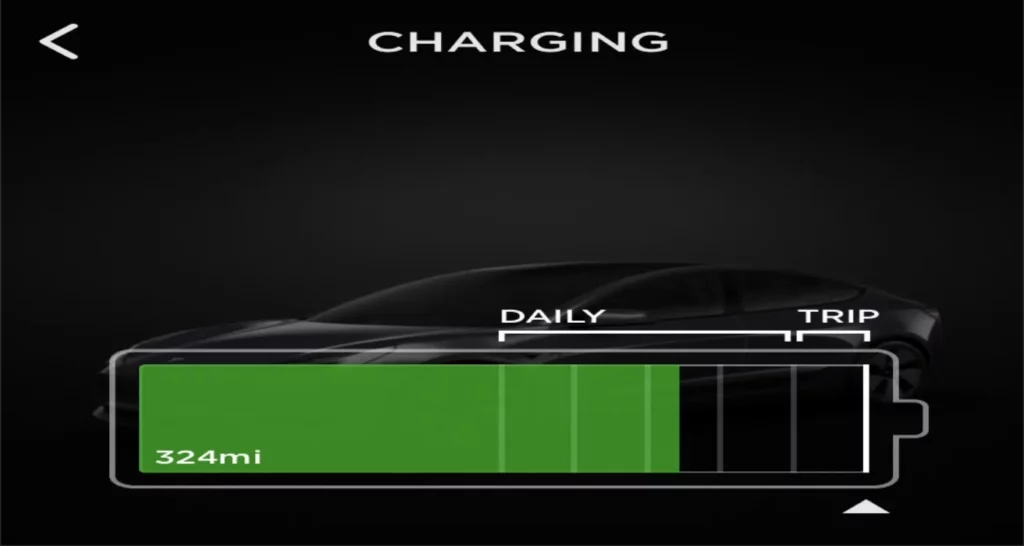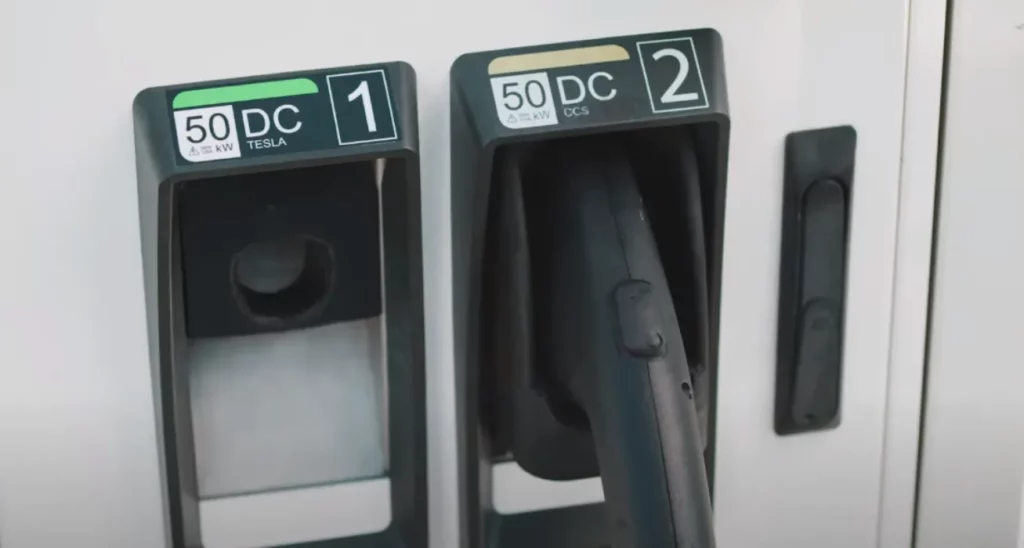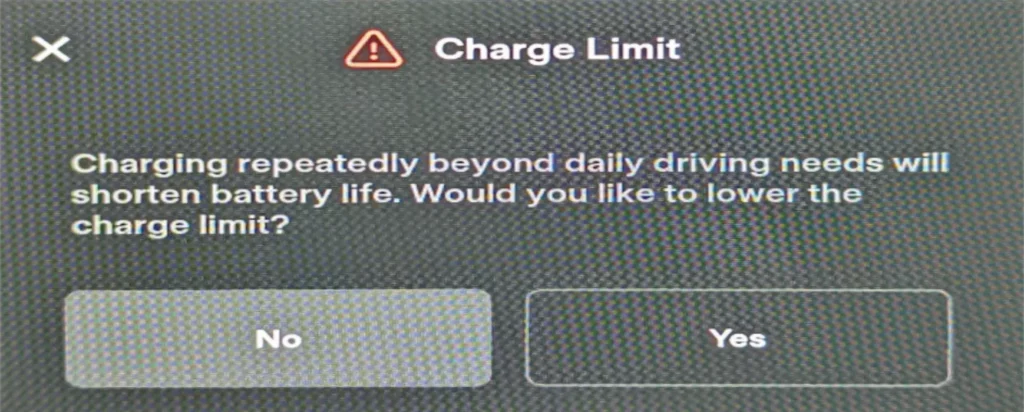Many new and older Tesla owners are concerned about the best charging habits to adopt to get the most out of their vehicles. One of their common questions is, how often should I charge my Tesla to 100?
You should never charge your tesla to 100%.
Quick Glance:
- Users can occasionally charge their Tesla to 100% but avoid doing it frequently.
- Tesla suggests charging High-performance Models with LFP chemistry on their battery pack to 100% once per week.
- Tesla recommends keeping the charge limit 20 to 80% for charging Tesla Lithium-ion batteries daily.
- Elon Musk has warned users not to charge above 90 – 95% since it will prevent them from reaping the full benefits of Tesla Regenerative braking.
However, if you’re curious, keep reading this article to find out why you shouldn’t do this and what are the facts behind this.

Tesla’s Official Guidance on Charging Habits

Tesla owners should note the following charging habits while charging their cars:
1. The Optimal Charging Habit for Daily Use:
Charge your car when the battery level is around or below 20% and unplug it from the charger when the battery reaches 80%.
Since these cars are designed to automatically manage the charging process to keep the battery within its optimal temperature range, Tesla also recommends all Model owners to keep their car plugged into a charger whenever it is possible for them.
2. Tesla Warns Against Using A DC Fast Charger:

Using the DC charger for the Model S and X frequently may cause battery degradation over time. However, the occasional use of DC chargers is not bad for them.
On the other hand, Model 3 and Y cars have differing battery designs designed to handle high-speed charging more efficiently. So, regular use of a DC charger is acceptable for them.
3. Tesla Suggests Using Scheduled Departure:
This built-in charging feature allows you to set a desired departure time. Therefore, your vehicle will optimize the charging process to reach the desired battery level by that time.
According to Tesla, this feature lets Tesla drivers and owners take advantage of off-peak electricity rates or optimize their charging process based on their daily routines.
4. For A Long-distance Trip:
Tesla highly recommends using its Supercharging Network to recharge your car quickly and easily. Tesla has strategically placed these charging stations on major and popular routes so that users can take a quick stop to recharge their cars on the way.
Tesla Supercharger can rapidly charge the battery to around 80% in approximately 30 minutes. That is why Tesla advises planning charging stops along the route at each Supercharger.
Tesla provides a feature called “Trip Planner,” which allows owners to temporarily charge the battery to 100% for these specific situations.
5. For Storing Your Tesla for A Long Period:
Tesla advises you to keep your Tesla plugged in with the charge limit set between 50% to 80% to maintain the battery’s health and readiness.
How Often Should I Charge My Tesla To 100%?
Tesla generally does not recommend charging Tesla vehicles to 100% daily. By default, your Tesla car will charge up to 90 to 95%.
Tesla electric vehicles are equipped with lithium-ion batteries, and it is advised that you should keep these batteries as near to 50% as possible for best performance and longevity.
Tesla has previously advised a maximum daily charge limit of 90% to prevent battery damage. But now recommending an 80% daily charge limit.
Tesla suggests only charging your Tesla to 100% on special occasions, such as going on a long trip. Such occasional charging to 100% will not cause substantial degradation of the battery.
But if you own a Tesla car whose battery pack has LFP chemistry, like Model 3 Standard Range Plus or Model Y Standard Range car, Tesla recommends charging the battery to 100% once a week.
When Should I Charge My Tesla To 100%?
If you’re encountering any of the following scenarios, you may charge your Tesla battery to 100%:
During a Long-Distance Travel or Trip:
If you are going to another state or taking a long-distance trip across the country, you should charge your car 100% or full level to maximize your driving range. This will allow you to start your trip with a full battery and reduce the need for frequent charging stops along the way.
Even though you can take a quick stop on the way to top off your car’s battery since the Tesla Supercharging network has a wide global reach, this will still be handy if you are planning trips to remote places with limited charging facilities.
Extreme Cold Weather Conditions:
Intense weather conditions like freezing cold or heavy snowfall can affect your car range significantly and the range will drastically drop.
Since Tesla cars are equipped with Lithium-ion batteries and these batteries tend to lose power or energy faster in too-cold temperatures, recharging your car’s battery to the fullest level will help mitigate the impact of lower temperatures.
Thus, if you are planning on driving your Tesla in such extreme weather conditions, remember to recharge your car to 100% before you start the journey. It will ensure that you do not run out of power in the middle of the road in such bad weather.
Note that Tesla does not recommend driving in either too humid or too cold weather conditions.
If Equipped with Lithium Iron Phosphate Batteries:
If you own one of the rear-wheel Tesla Models such as Model 3 (Standard Range Plus) or Model Y (Standard Range), you can charge your car to 100% level.
Since these cars are equipped with Lithium Iron Phosphate batteries (LIFEPO4), commonly known as LFP batteries, these batteries do not degrade if you charge them to the full level.
Performance Requirements During Spin-off Challenges:
Some high-performance Tesla models, such as Model S Plaid require a 100% charge to unlock additional power and acceleration capabilities during track day and Drag racing performance.
So, if you plan on participating in such spin-offs or a performance-oriented event, you should fully charge your Tesla to optimize its performance.
During Tesla’s Firmware Updates:
If you own a Tesla, you must already know that Tesla often releases its firmware software updates to improve the car’s overall safety, performance, and capabilities.
Tesla advises users to charge their batteries to 100% while updating the firmware software.
Read Also: The Ultimate Guide To Make the Most of Tesla Off Peak Charging!
Can Charging My Tesla to 100% Damage Its Battery?
Actually, it depends on the frequency of your charging to 100%. Once in a while or occasionally charging to 100% will not damage the battery.

But if you consistently charge your Tesla to 100%, that can potentially lead to faster battery wear and a higher degradation rate.
Tesla cars are designed with a Battery Management System (BMS) that consistently monitors and regulates the charging process.
The BMS maintains the battery within the optimal voltage range and performs cell balancing to prevent any potential damage due to overcharging and undercharging.
But regularly charging your battery to the full level can cause unnecessary strain on its longevity.
That is why Tesla suggests keeping the regular charging limit between 60% and 80% or up to 90% max.
Read Also: Is Supercharger Bad for Your Tesla EV?
Frequently Asked Questions [FAQs]
Is it required to charge my Tesla to 100% every day?
No, it is not necessary. Even charging your Tesla battery to 100% daily can degrade the battery faster. For daily charging, keep the charging limit between 20% – 80% max.
Can I use a Tesla Supercharger to charge my Tesla to 100%?
Yes, you can charge your Tesla to 100% using a Supercharger but avoid doing it frequently.
Will charging my Tesla to 100% limit its overall range?
No. If you do this on occasion, it will not dramatically reduce your Tesla’s range. However, repeated full charges may reduce your car’s long-term capacity.
Can charging my Tesla to 100% effect on charging speed?
Charging your Tesla battery to 100% regularly may result in a modest drop in charging speed over time.
